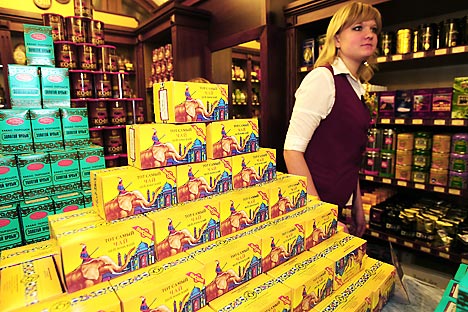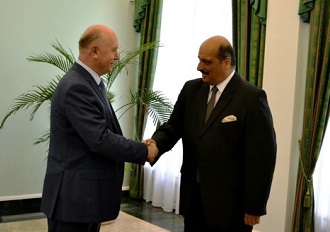Indian tea regains popularity in Russia

The image of Indian tea has been restored and its popularity is increasingly rising as Russians now again have started liking the taste of Indian teas and buying more and more of the Indian brands. Source: PhotoXPress
Thanks to a series of urgent measures recently taken by the Tea Board of India and the Indian Embassy in Moscow, to win back the Russian tea market from other major international players, the good reputation and popularity of Indian tea has once again been revived. This has been demonstrated by a significant increase in the tea exports to Russia from India in 2013, both in terms of quality and value.
The revival of popularity of the Indian tea in Russia, became possible as a result of a series of key promotional programmes launched by the Tea Board of India under the chairmanship of M.G.V.K. Bhanu. These programmes aimed at restoring the “image of Indian Tea” in Russia, included public tea tasting, competitions and visits to tea growing areas, charity auction, publicity through social media and print media.
In addition to this, the Tea Board has also been conducting “frequent and mass tea tasting and sampling” programmes during various festivals and events in Moscow and other regions of Russia. Indian tea videos, photographs and tea-related interesting stories were publicized through social media and YouTube. For example, at a charity auction held in Moscow, India’s Darjeeling Tea fetched the highest-ever record price of Rs 89,000 per kg of tea.
The outgoing Indian ambassador to Moscow, Ajai Malhotra has always been keenly interested in restoring the image of Indian tea in Russia, trying to spread the message of the popularity of Indian tea with cultural traditions during his official visits to different regions across the country.
Today, Russia is the largest buyer of Indian tea, with its imports around 41 million kg tea per annum, mainly as bulk tea, which constitutes 25 percent of Indian tea exports. With per capita consumption of 1.2 kg tea annually, Russia consumes 192 million kg per annum. Although annual demand for tea, remained more or less same in Russia over the years, consumer preferences have been shifted to specific teas and premium quality segments. Russians are becoming increasingly health-conscious everyday and tea is being considered and accepted as a health drink.
Before the collapse of the Soviet Union, Indian tea was the sole tea available in the Russian market. However, after the break-up to the Soviet Union, teas from countries such as Sri Lanka, Kenya and Vietnam started coming to Russian market. In particular, Sri Lanka with its aggressive marketing and promotional efforts became the number one supplier of teas to Russia, pushing down India to second place.
There were many reasons for India ceding its leading position to Sri Lanka in tea exports to Russia, which included collapse of barter system (rupee-rouble trade), strong growth in domestic consumption in India, dismantling of central purchase system, deterioration of quality of exported tea from India, demand for cheap Indian teas in Russian market, payment problems and diversion of export business to European and Middle east markets.
Specially, there had been an identity crisis for the Indian tea in Russia, and traders started selling low-quality tea blended with other origin tea as Indian tea, which rendered a major blow to the image of the Indian tea in the Russian market. Even today people in Russia fondly remember the good old “Elephant” brand Assam Tea from India during the Soviet-era.
But as a result of the consistent efforts made by the Tea Board of India jointly with the Union Ministry of Commerce and Industry, the image of Indian tea has been restored and its popularity is increasingly rising as Russians now again have started liking the taste of Indian teas and buying more and more of the Indian brands. Exclusive brands of the Assam, Darjeeling and Nilgiri teas have started reappearing in many retail chains and Boutiques, in Russia.
Recently ORIMI Trade, the highest stake holder in tea industry in Russia has launched an exclusive Premium Assam brand in the market. The same path is being followed by other players like Mayski and Ahmed Tea.
Related:

Russia seeks details of dilution in Indian tea speciality tag
'Competition is now among brands and not tea-producing regions'
It may be recalled that within India also, the Tea Board has taken a number of strict measures to ensure quality at all levels of tea being exported to Russia and this fact has been acknowledged by both Russian buyers and customers. It has also taken steps to register the logos of Assam, Darjeeling and Nilgiri teas in Russia known as Geographical Indication (GI) as quality indicators. Earlier, several Indian tea makers had lodged complaints against alleged dilution of GI of Assam, Darjeeling and Nilgiri teas through mixing of these teas with other varieties in Russia.
Recently besides the GI brands of Assam, Darjeeling and Nilgiri teas, the demand for Indian Masala Tea in the Russian market is also increasing. According to experts, there is a lot of scope for developing the Indian Masala Tea as a health drink under a specialty tea category in Russia. It has already become a hot selling item in Indian restaurant chains across Russia.
It is expected that with Russia’s recent accession to WTO, the customs duty will be reduced from 20 percent to 12.5 percent by 2017, which will be an additional advantage for Indian tea exports to Russia.
Dadan Upadhyay is an Indian journalist based in Moscow.
All rights reserved by Rossiyskaya Gazeta.
Subscribe
to our newsletter!
Get the week's best stories straight to your inbox
